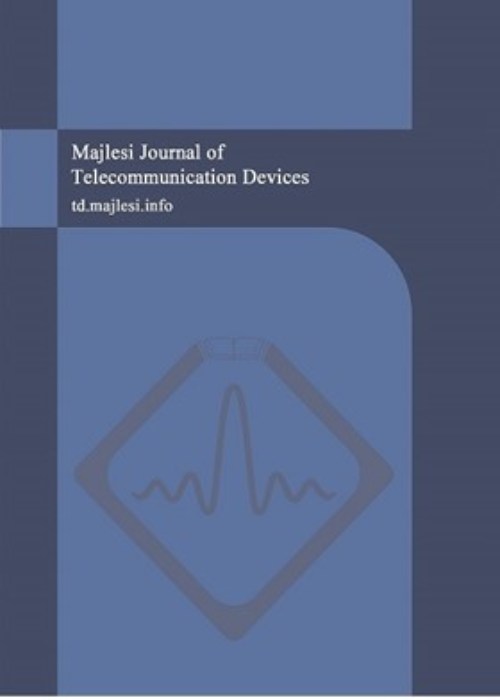فهرست مطالب
Majlesi Journal of Telecommunication Devices
Volume:3 Issue: 1, Mar 2014
- تاریخ انتشار: 1393/02/22
- تعداد عناوین: 7
-
Pages 1-8This paper provides useful equations for the analysis of loop dynamics specification such as damping ratio, overshoot and settling time in the third-order charge pump PLL with second-order loop filter. The presented analysis method is based on the approximation of the output phase step response using the step response of the second-order systems. In fact, the results can be used as an accurate approximation in the design and analysis of third-order PLL. The performance of this method has been verified in an interesting example using behavioral simulations in MATLAB. Simulations demonstrate a significant agreement between the simulated results of the actual PLL and the proposed approximated approach.
-
Pages 9-13Orthogonal frequency division multiplexing (OFDM) suffers from high out-of-band (OOB) radiation. Constellation expansion (CE) is one of the methods for reduction of OFDM sidelobes that has a good performance. In CE, no side information needs to be transmitted and it doesn’t involve complex optimization problem but, it has an increment in the bit error rate (BER) parameter. In this method, the symbols map to the high order constellation that, the CE performance depends on this map of symbols. The selected map directly affects on sidelobes reduction. In this letter, we compare the different maps in CE method and propose a suitable map that has the best sidelobes reduction. Simulation results show that the proposed map reduces the OFDM sidelobes significantly.
-
Pages 15-19Nowadays, the multiple antenna transmission technique, which may be modeled as Multiple Input Multiple Output (MIMO) systems, is used for increasing the capacity of the wireless communication systems. However, complexities and cost are associated with MIMO systems. Here, we propose a technique based on Imperialist Competitive Algorithm (ICA) to reduce the computational complexity and hardware cost. A new suboptimal configuration on antenna selection both in receiver and transmitter sides is the outcome of applying our method on MIMO systems. Our algorithm achieves almost the same outage capacity as the optimal selection technique while having lower computational complexity than the exiting nearly optimal antenna selection methods such as genetic algorithms. The antenna selection algorithm requires an exhaustive search of all possible combinations and permutations to find the optimum solution at the transmitter or receiver side, thus resulting in extremely high computational complexity. To reduce the computational load while still maximizing channel capacity, the ICA method is adopted to determine the suboptimum solution. The simulation results show that the ICA method has better performance from the point of view of both computational and time complexities, when compared with the Genetic Algorithm (GA) and Exhaustive search method (ES).
-
Pages 21-25Due to geometrical errors, complexity, and interference, the steering vector in large-scale antenna arrays needs to be accurately calculated. Beamforming methods based on adaptive processing can effectively overcome complexities and limitations of large-scale arrays. Here, we present the projection-based parallel linearly-constrained minimum variance (PBPLCMV) algorithm which calculates the steering vector of the desired signal through projecting the assumed steering vector onto the signal subspace. Then, the optimum weights of the adaptive beamformer are calculated using the parallel linear constrained minimum variance (PLCMV) algorithm. The simulation results show that for low input SNRs, the proposed method has better performance and output SINRs up to 18 dB more than the output SINRs of the parallel robust recursive linearly constrained minimum variance (PRRLCMV).
-
Pages 27-34In this paper, we investigate the channel selection technique in secondary user communication in cognitive radio network using rateless codes. In order to increase the tolerance of interference from the primary user appearance, also considering losses caused by collision between several secondary users, each secondary user uses rateless codes. We model the primary user occupancy and interference dynamics of a channel, which is used by a secondary user, using a Hidden Markov Model (HMM). The HMM is trained using Baum-Welch procedure and each secondary user uses a trained HMM to predict the primary user channel occupancy in future time slots and compute the Channel Availability Metric (CAM) for the channel. CAM is used by secondary user to select a preferable primary user channel for its communication. Simulation results, demonstrate the efficiency of the proposed channel selection technique in secondary user communication.
-
Pages 35-40In this article decreasing of crosstalk phenomenon optic two-channel demultiplexer to use in DWDM communicational systems with 2D photonic crystal structure has been suggested. In this research, designed two-channel demultiplexer resulted in decrease in crosstalk phenomenon to the average of -22.11 dB in photonic crystal two-channel demultiplexer according to ultra channel spacing with distance of 0.8 nm, ultra narrow bandwidth mean of 0.25 nm, and quality factor Q with ultra average amount of 6582. PWE calculation methods were used to obtain band structure and photonic band gap and FDTD numerical calculation method was used to obtain output spectrum of photonic crystal two-channel demultiplexer.
-
Pages 41-47In recent years, Inter-vehicle communication (IVC) has received great attention due to its many advantages such as public safety and reduction of accidents, traffic management, video and audio transmission between vehicles. Also, the 60 GHz frequency band with 7GHz bandwidth is good for video and audio transmission with HD quality and high data rate transmission (Gbps). But design of Communication systems need suitable channel model that is as simple and accurate as possible. In this paper, we propose vehicle-to-vehicle (V2V) channel model in 60 GHz Band. This model is combination of ray-tracing and cluster-based scattering models and its structure based on tapped delay line. In addition to geometry and material of environment, proposed model can also model Doppler spectrum of both mobile and stationary scatterers.


